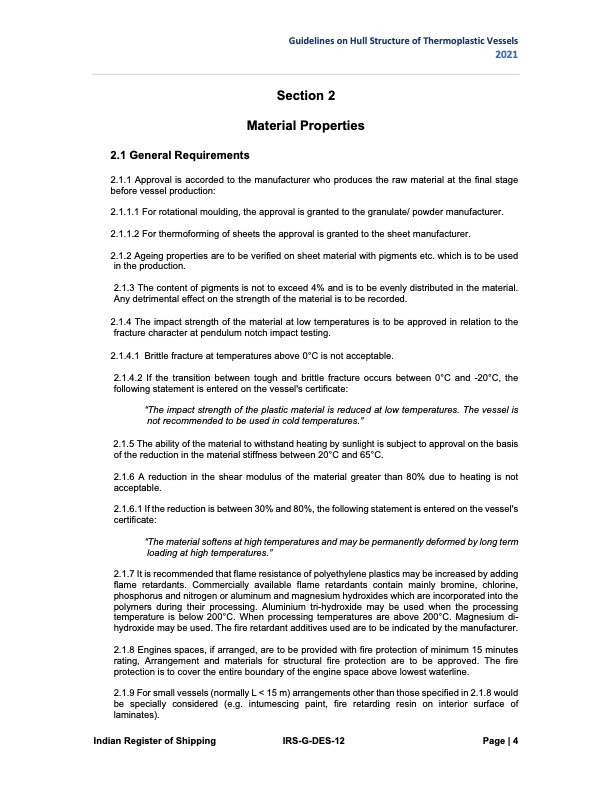
PDF Publication Title:
Text from PDF Page: 004
Section 2 Material Properties 2.1 General Requirements Guidelines on Hull Structure of Thermoplastic Vessels 2.1.1 Approval is accorded to the manufacturer who produces the raw material at the final stage before vessel production: 2.1.1.1 For rotational moulding, the approval is granted to the granulate/ powder manufacturer. 2.1.1.2 For thermoforming of sheets the approval is granted to the sheet manufacturer. 2.1.2 Ageing properties are to be verified on sheet material with pigments etc. which is to be used in the production. 2.1.3 The content of pigments is not to exceed 4% and is to be evenly distributed in the material. Any detrimental effect on the strength of the material is to be recorded. 2.1.4 The impact strength of the material at low temperatures is to be approved in relation to the fracture character at pendulum notch impact testing. 2.1.4.1 Brittle fracture at temperatures above 0°C is not acceptable. 2.1.4.2 If the transition between tough and brittle fracture occurs between 0°C and -20°C, the following statement is entered on the vessel's certificate: “The impact strength of the plastic material is reduced at low temperatures. The vessel is not recommended to be used in cold temperatures.” 2.1.5 The ability of the material to withstand heating by sunlight is subject to approval on the basis of the reduction in the material stiffness between 20°C and 65°C. 2.1.6 A reduction in the shear modulus of the material greater than 80% due to heating is not acceptable. 2.1.6.1 If the reduction is between 30% and 80%, the following statement is entered on the vessel's certificate: “The material softens at high temperatures and may be permanently deformed by long term loading at high temperatures.” 2.1.7 It is recommended that flame resistance of polyethylene plastics may be increased by adding flame retardants. Commercially available flame retardants contain mainly bromine, chlorine, phosphorus and nitrogen or aluminum and magnesium hydroxides which are incorporated into the polymers during their processing. Aluminium tri-hydroxide may be used when the processing temperature is below 200°C. When processing temperatures are above 200°C. Magnesium di- hydroxide may be used. The fire retardant additives used are to be indicated by the manufacturer. 2.1.8 Engines spaces, if arranged, are to be provided with fire protection of minimum 15 minutes rating, Arrangement and materials for structural fire protection are to be approved. The fire protection is to cover the entire boundary of the engine space above lowest waterline. 2.1.9 For small vessels (normally L < 15 m) arrangements other than those specified in 2.1.8 would be specially considered (e.g. intumescing paint, fire retarding resin on interior surface of laminates). Indian Register of Shipping IRS-G-DES-12 Page | 4 2021PDF Image | Hull Structure of Thermoplastic Vessels 2021

PDF Search Title:
Hull Structure of Thermoplastic Vessels 2021Original File Name Searched:
guidelines-on-thermoplastic-boats.pdfDIY PDF Search: Google It | Yahoo | Bing
Development of a solar powered Electric Ship The Electricship website originally started off as a project to develop a comprehensive renewable, affordable, modular electric ship... More Info
Modular Boat Hull Composite The case for a unsinkable, modular composite hybrid boat hull... More Info
MS Burgenstock Hybrid Electric Catamaran Lake Lucerne Unique shuttle servicing Lucerne to the Burgenstock Resort... More Info
Ground Power Unit GPU Powered by Lithium Ion Batteries The goal of the Ground Power Unit is to provide a readily accessible, modular, ready-to-power solution for remote power... More Info
| CONTACT TEL: 608-238-6001 Email: greg@electricship.com | RSS | AMP |